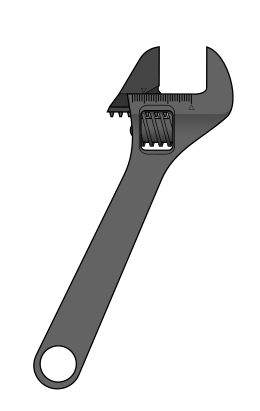Adjustable spanner


2. Adjustable wrench from 1910 with an improved handle (BAHCO)
3. Adjustable wrench from 1915 with a slightly rounder handle (BAHCO)
4. Adjustable wrench from 1954 with improved handle and new jaw angle of 15 degrees (BAHCO)
5. Adjustable wrench from 1984 and the first with ERGO handle (BAHCO)
6. Today's version of the adjustable wrench from 1992 with ERGO (BAHCO)
An adjustable spanner (UK, and most other English-speaking countries) or adjustable wrench (US and Canada) is an open-end wrench with a movable jaw, allowing it to be used with different sizes of fastener head (nut, bolt, etc.) rather than just one fastener size, as with a conventional fixed spanner.[1] Several other names are in use, including casually imprecise use of a US trademark as crescent wrench.[2]
Forms and names
English engineer Richard Clyburn is credited with inventing an adjustable spanner in 1842.[3] Another English engineer, Edwin Beard Budding, is also credited with the invention.[4][5] Improvements followed: on 22 September 1885 Enoch Harris received US patent 326868[6] for his spanner that permitted both the jaw width and the angle of the handles to be adjusted and locked. Swedish company Bahco attributes an improved design, in 1891 or 1892, to Swedish inventor Johan Petter Johansson.[7][8] who in 1892 received a patent[9] Johansson's spanner was a further development of Clyburn's original "screw spanner". In Canada and the United States, the tool is known as a Crescent wrench or an adjustable wrench.[2]
There are many forms of adjustable spanners, from the taper locking spanners which needed a hammer to set the movable jaw to the size of the nut, to the modern screw adjusted spanner. Some adjustable spanners automatically adjust to the size of the nut. Simpler models use a serrated edge to lock the movable jaw to size, while more sophisticated versions are digital types that use sheets or feelers to set the size.
The fixed jaw can withstand bending stress far better than can the movable jaw, because the latter is supported only by the flat surfaces on either side of the guide slot, not the full thickness of the tool. The tool is therefore usually angled so that the movable jaw's area of contact is closer to the body of the tool, which means less bending stress. For this reason, it's good practice to exert the force on tight bolts toward the movable jaw rather than away from it, for the latter can pry open the mounting of the movable jaw causing the wrench to no longer be able to be snugged to bolt heads, loosen too easily, mar bolt heads, or be ruined entirely.
Monkey wrenches are another type of adjustable spanner with a long history; the origin of the name is unclear.[10]
The type of straight adjustable spanner with jaws at right angles to the handle shown here as an "English Key" is mainly called a "King Dick" spanner in the United Kingdom because of a popular British brand of small, handy and reliable adjustable spanner used throughout the 1900s and used in great numbers during World War II.[11]
A popular type of adjustable spanner has a base and jaws that form four (4) sides of a hexagon, and is therefore particularly suited for hexagonal nuts ("hex nuts") and hexagonal headed ("hex head") cap screws and bolts.
In the United States and Canada, the adjustable spanner (adjustable wrench) is sometimes colloquially referred to as a "crescent wrench" due to the widespread Crescent brand of adjustable wrenches; the former Crescent Tool Company was the assignee of the 1915 U.S. patent for the most familiar form factor of adjustable wrench.[12] The Crescent brand of hand tools is now owned and marketed by Apex Tool Group, LLC. In some parts of Europe, "adjustable spanners".[13] are often called a Bahco.[8] This term refers to the company of the Swedish inventor Johan Petter Johansson, which was originally called B.A. (Bernt August) Hjort & Company. The Swedes themselves call the key "skiftnyckel" which is translated into adjustable key (shifting key).[14] In Australia adjustable spanners are can also be referred to as "shifters".[15]
 A French key
A French key An English key
An English key The "keyway" of an adjustable wrench
The "keyway" of an adjustable wrench Chrome vanadium adjustable wrench
Chrome vanadium adjustable wrench Adjustable wrench for hexagonal ("hex") fasteners
Adjustable wrench for hexagonal ("hex") fasteners
See also
- Pipe wrench or Stillson wrench
- Plumber wrench
- Monkey wrench
- Channellock
- Diamond Calk Horseshoe Company
References
| Wikimedia Commons has media related to Adjustable wrenches. |
- ↑ FCS Engineering Technology L2. Pearson South Africa. 2009. pp. 161–. ISBN 978-1-77025-592-0.
- 1 2 Bonnier Corporation (October 1999). Popular Science. Bonnier Corporation. pp. 21–. ISSN 0161-7370.
- ↑ Murray, John (1845). The Journal of the Royal Agricultural Society of England. pp. 388–.
- ↑ John Lloyd; John Mitchinson; James Harkin (30 October 2012). 1,227 QI Facts To Blow Your Socks Off. Faber & Faber. pp. 44–. ISBN 978-0-571-29795-5.
- ↑ Lance Day; Ian McNeil (11 September 2002). Biographical Dictionary of the History of Technology. Routledge. pp. 206–. ISBN 978-1-134-65019-4.
- ↑ http://patimg2.uspto.gov/.piw?docid=00326868&SectionNum=3&IDKey=D972A8368E25
- ↑ "About Us | BAHCO". www.bahco.com. Retrieved 2016-11-04.
- 1 2 Swedish Bahco leaflet about the development history of adjustable spanners (including photos) Archived October 15, 2006, at the Wayback Machine.
- ↑ Andreas Bergh (31 July 2014). Sweden and the Revival of the Capitalist Welfare State. Edward Elgar Publishing. pp. 11–. ISBN 978-1-78347-350-2.
- ↑ The Davistown Museum — The Boston Wrench Group
- ↑ Motor Transport. Iliffe and Sons, Limited. 1908.
- ↑ U.S. Patent 1,133,236A
- ↑ https://manoffamily.com/best-adjustable-wrench/
- ↑ Basic Swedish: A Grammar and Workbook ISBN 1-351-16966-1 p. 177
- ↑ https://www.collinsdictionary.com/dictionary/english/shifting-spanner